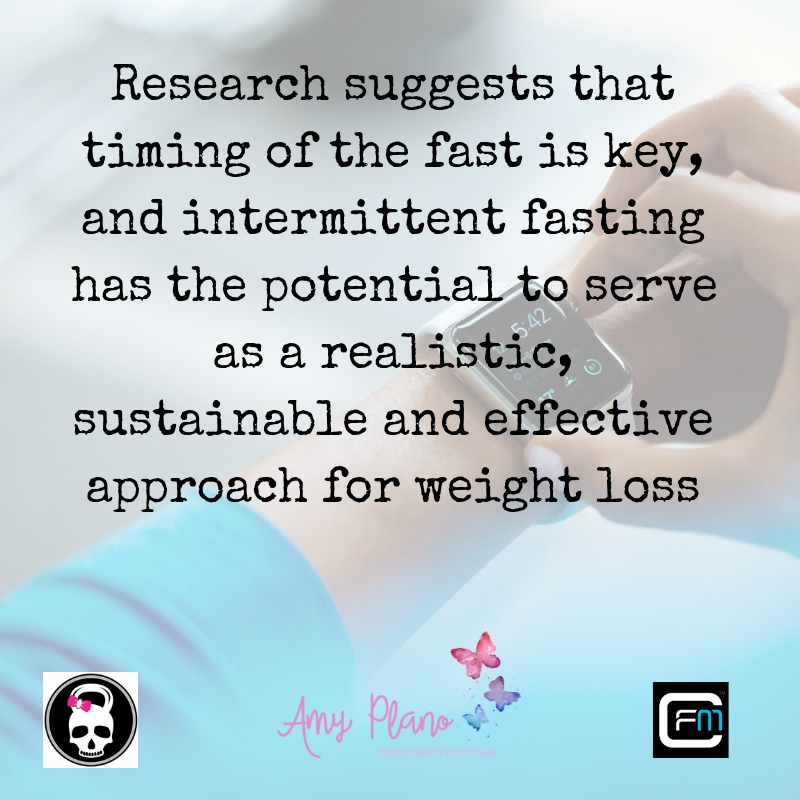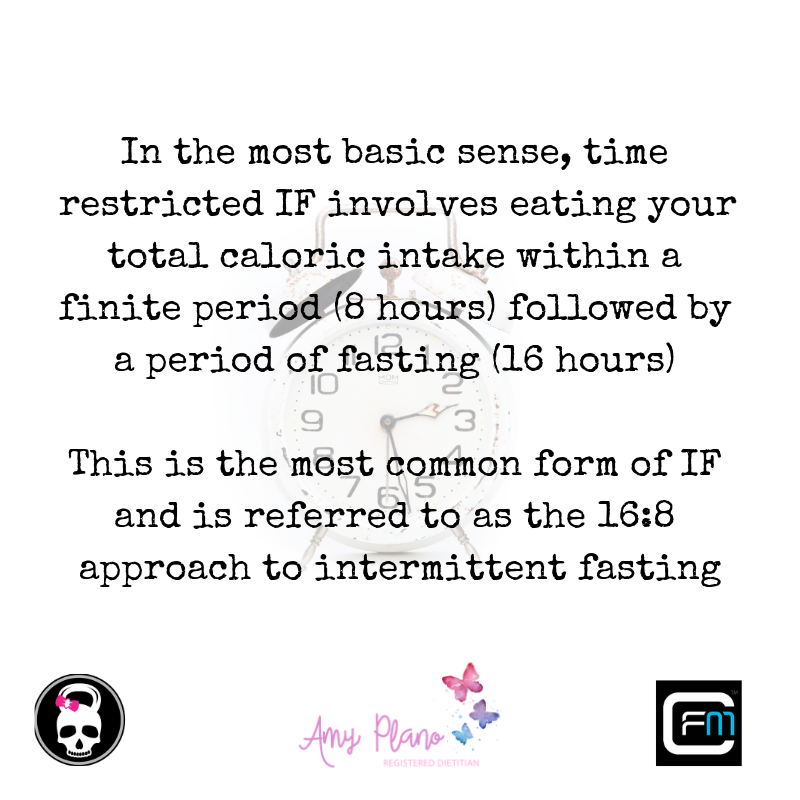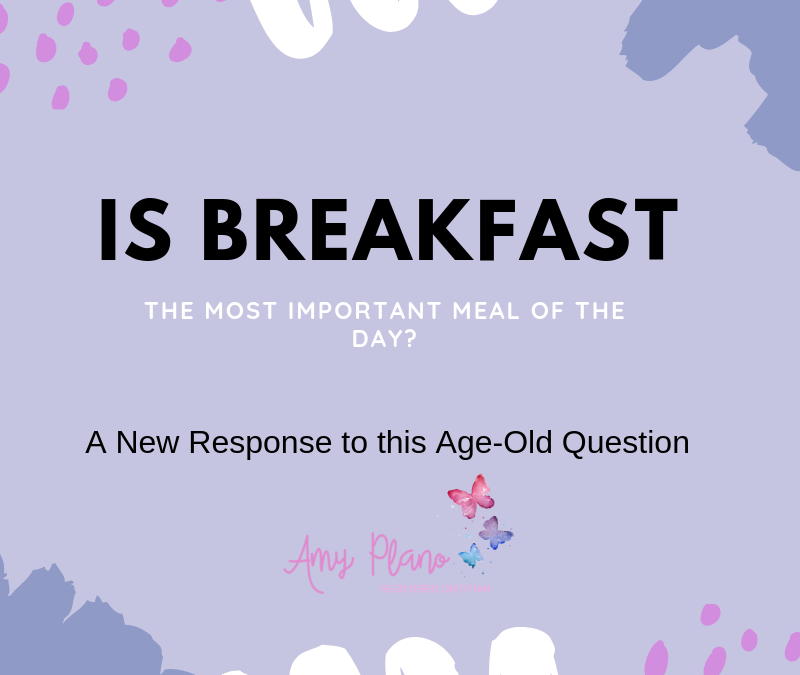Is Breakfast the Most Important Meal of the Day?
Back in the day (many, many, many moons ago!) when I was in grad school I remember one thing being drilled into our heads by our Professors – “Encourage your patients to eat more often.” For years, we’ve been told it’s important to eat breakfast within an hour of waking up in an effort to ‘rev up’ our metabolism. To this day, we preach to our patients to eat small, frequent meals and snacks throughout the day to the same effect. But a more recent trend, intermittent fasting, seems to have thrown a cog in the wheel of this nonsense we have been propagating for way too long. This highly effective technique relies on restricting your eating to set times and alternating between feasting and fasting.
The goal of this blog is to define the most popular form of intermittent fasting 16:8, its health implications as well why it seems to work. Future blogs will address the details of IF including when and what to eat as well as the new emerging research as it relates to weight loss, diabetes prevention and reversal as well as optimizing body composition.
What is intermittent fasting?
Intermittent fasting is a hot topic. No matter where I seem to go – someone seems to be chatting up intermittent fasting (IF). But what the heck is IF? And more importantly why is everyone talking about it?
Intermittent fasting has recently emerged as a popular eating style. IF has dietary implications for everything from weight management, to mitigating inflammation to even decreasing the ugly symptoms of chemotherapy. Research suggests the timing of the fast is key. This powerful approach to eating has the potential for IF to serve as a realistic, sustainable, and effective approach for weight loss, as well as for diabetes prevention (1).

In an attempt to streamline my efforts, this blog (and future blogs on the topic) will focus on the body composition and the weight management applications of intermittent fasting. However, that does not mean the other benefits are less important. It just means the questions I receive most commonly in my practice relate to weight loss. So it makes sense to address this aspect.
16:8 the most popular approach to intermittent fasting
There are various formats for intermittent fasting. The most common approach is referred to as time restricted intermittent fasting. In the most basic sense time restricted IF involves eating your caloric intake within a finite period (generally 8 hours) followed by a period of non-eating or fasting (generally 16 hours). This is the most popular approach to intermittent fasting and is commonly referred to as the 16:8 approach to intermittent fasting.
The 16:8 approach by definition is simple. The ‘16’ refers to the hours in which we are not eating and the ‘8’ refers to the eating window in which we are eating.
Depending upon when someone decides to execute their 16-hour fast it is very possible they might actually be sleeping for a majority of the time they are fasting! More so, for most people participating in this style of eating they are simply skipping breakfast and consequently having lunch as their first meal. If your mornings are pretty busy, or you just don’t love eating first thing in the morning – the time seems to fly by. Making this approach particularly easier than other formats such as “The 5:2 Diet” were you are encouraged to eat 500 – 600 calories on two non-consecutive days or “The Alternative Fast Diet” where you fast every other day.
Alternate day fasting is quite an extreme form of intermittent fasting. It may not be suitable for beginners or those with certain medical conditions. It may also be difficult to maintain this type of fasting in the long-term. Each person’s experience of intermittent fasting is individual, and different styles will suit different people. However, from my clinical experience I have seen the most success and compliance with the 16:8 approach to intermittent fasting.

So sounds pretty simple, right? You eat for 8 hours. You fast for 16 hours. But why is that eating window so dang important? SO glad you asked.
The power of insulin and intermittent fasting
Believe it or not there is one thing that pretty much controls how effectively we lose weight. This crucial thing is called insulin. Insulin is a powerful hormone secreted by the pancreas. Truth be told – insulin is pretty much responsible for the fate of our fat cells.
You see when we eat our body breaks down food into smaller components. One of these smaller units is glucose (aka sugar). The glucose from our food enters our bloodstream to be transported to our cells where it is processed and used to fuel the body. While glucose helps provide our cells with the energy they need to do their jobs; its very presence increases our levels of insulin.
Once the body receives the signal you’ve eaten, insulin is produced and released in response to glucose. Unfortunately, when the body senses high levels of circulating insulin it only hears one message and one message only, “Store excess calories as fat.” Insulin slows down fat burning while the body instead burns glucose from its last meal.
For that reason, from a body composition standpoint we want keep insulin levels as low as possible (2). We don’t want no stinkin’ fat storage! Do we? No, thank you!

I want you to think about insulin like the mission control center of your fat cells. The presence of insulin dictates whether we store calories as fat or burn them for energy. Take for example the fed state. After we have eaten a mixed meal (one with carbohydrates, protein and fat) insulin increases and a message is sent to our body to store fat. However, when we are not eating – that message is silenced. During the fasting state, the body burns more stored fat for energy. And guess what – if we burn more fat as fuel we are more likely to optimize our body composition. Bingo – now we are on to something!
So, is breakfast the most important meal of the day? Heck no!
So that reminds me. Let’s go back to that original scenario. Remember the one that has been drilled into your head about eating small frequent meals and snacks? The one that always – no matter what – starts with consuming a big healthy breakfast. Does it now make sense why that method is pretty much counter productive to optimizing body fat?
Think about it. If we are eating every couple of hours in an effort to as they used to say ‘put fuel on the fire’ what is constantly high? Insulin, right? If insulin is constantly high your body is constantly shoveling excess calories into your fat cells. No bueno!
Conclusion
So bottom line, in the fed state, insulin is elevated, and this signals your body to store excess calories in your fat cells. In the presence of insulin, the burning of fat is halted, while the body burns glucose (from your last meal) instead.
In the fasted state, insulin is low. The body starts mobilizing stored body fat from your fat cells and burns this fat for energy (instead of glucose).
The practical importance of all this? By choosing to follow a 16:8 time restricted form of intermittent fasting where you eat for 8 hours and fast for 16 hours you can optimize your body composition. By choosing this pattern of eating you are limiting the time in which your body is releasing insulin. Thus prompting your body to burn stored body fat while in the fasted state, while minimizing fat storage in the fed state.
In our next blog on this topic we will dive into the specifics of the 16:8 approach to intermittent fasting. I will teach you how to apply the 16:8 approach, how to choose the best time frame for the fast/fed state as well guide you on what to eat.
Don’t miss out on this exciting event
Did this blog get your noggin thinking? Want to learn more about the applications of intermittent fasting? If so – please come and hear Marc and I present on this very topic this Saturday, 9/29 at 11:30 am at Crossfit Milford. I guarantee this is an event you DO NOT want to miss.
Looking for further customization on your diet? All this talk about intermittent fasting got you confused? Then go ahead and make an appointment with either Audrey or Emily in my practice and they will help you come up with a customized meal plan using intermittent fasting.
Hugs & High Fives, Amy
P.S. Did you know The Plano Program Dietitians accept most health insurance? We sure do!
P.P.S. Love the information presented on intermittent fasting? Have a friend who you think could benefit? Please share the social love ♥
References
(1) Patterson RE, Laughlin GA, Sears DD, et al. Intermittent Fasting on Metabolic Health. Journal of the Academy of Nutrition and Dietetics. 2015;115(8):1203-1212.
(2) Tinsley GM, La Bounty PM. Effects of intermittent fasting on body composition and clinical health markers in humans. Nutrition reviews. 2015 Oct 1;73(10):661-74.


Amy great info, I am interested in learning more. Hearing a lot about this.
Thanks Faye! I am going to do my best to complete a ‘series’ on intermittent fasting – giving more information in future blogs on how to apply the information. Application of stuff like this makes all the difference. Thank you for taking the time to read the blog. I look forward to seeing you soon!
trillduncan@outlook.com I would like to start on IF but when I go to bed my tummy is growling and I can’t get to sleep. Is there something I can have to shut this down and not wake up my pancreas?